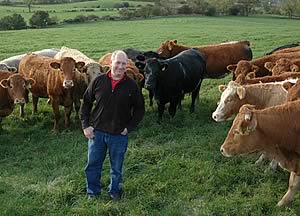 |
|||||||||
|
|||||||||||||||||||
|
|
Improved
Genetics,
Management and Nutrition for Beef Efficiency 14/03/07 Improved genetics, feed and management for technical performance and efficiency, combined with a firmer market place will be essential for beef producers to remain profitable in future as modulation begins to bite under the new regime and payments rapidly erode, according to Christopher Askwith.
“We have seen a welcome upturn in trade in the last 12 months thanks to the resumption of exports, both cull cows and bulls have returned to the food chain, and there were fewer beasts coming on to the market, however margins continue to remain very slim,” he said. “Beef has followed the same trend as the main arable commodities which are forecast to continue to remain firm in the short to medium term due to global influences and the emerging demand for biofuel. “Beef prices should follow suit in 2007 as the export trade begins to pick up, however the marketplace is really outwith farmers control. One thing we are attempting, and that is improve everything we’re doing at a technical level; we’re focusing on the golden triangle - genetics, management and nutrition.” Christopher Askwith with his brother Graham farms 425 acres based at Middle Mown Meadow, Crook. Former dairy producers, the Askwiths decided to introduce a beef enterprise post FMD and nowadays finish an annual 500 head of store cattle on a relatively low input least cost system. Continental cross steers are taken through to 650kgs within 12 months, and heifers, 550kg to 580kg within nine to 10 months. The entire throughput is sold through Darlington Auction Mart to repeat buyers, either for the high street retail trade or multiples. “In the first instance, we are particular where we source our cattle. We are very conscious that so many beef bred cattle nowadays suffer from the Holstein influence which is detrimental to performance, and you really cannot tell a beast’s potential in the ring by its looks,” he said. “So we buy in the vast majority of animals privately from suckler herds we know, to ensure they comprise pure beef bred genetics.” The brothers have minimised disease risk among winter housed cattle. “While we are sourcing our cattle from known herds, they were still prone to an outbreak of viral pneumonia and we were aware that our main cubicle house hadn’t sufficient ventilation,” he added. “Since we decided to reclad the entire building with Yorkshire boarding at 3.5cm spacings, we’ve seen a big difference. Pneumonia incidences have been reduced to nil, and the cattle appear a lot more contented.” When it comes to introducing new products to Middle Mown Meadow, Mr Askwith says: “You can get so channelled into using the same ones year in year out, however we like to try out new and different ones. For example, we’ve found Cydectin 10% LA, a new wormer for cattle which offers up to 150 days protection against worms from a single injection at turn out. “We’ve found it has a place; it is simple to inject in the ear, saves labour and it has proved to be effective. Initially we priced up the wormer and compared with bolus which we used to use, and it looked better because you could regulate the amount dozed to the size of the beast. “In our opinion the wormer injecting the wormer proved to be straightforward. In fact it was effortless - a 10 second job. We injected 200, eight to 18month olds in one day. A wormer which requires us to handle the beasts only once is essential because we summer graze them away from the main steading, and Cydectin LA certainly did the job we expected.” He added: “The product has a long cover and short withdrawal period, which suits us better. And after an extreme summer when the cattle were stressed a lot by the heat, flies and poorer quality grazing, we were really, really pleased with their condition at winter housing. We think they’ve come in a lot fitter and with a higher weight gain. This system is a lot more user friendly for both us and the beasts.” Improving nutrition is also high on the agenda. For example the Askwiths have improved their clamp grass silage quality by simply cutting one week earlier. A sample from last year’s clamp analysed D69.6, 11.0 ME, 27.6pc DM and 13.6pc protein. “Nowadays we go for the first week in June Consequently, we have been able to cut the winter feed bill by 25pc to 30 pc by removing bought in concentrate and soya from the diet and feeding a simple balanced mix of ad lib silage, home grown barley and wheat, plus minerals.” The brothers have also improved their silage making efficiency. The entire operation taking in 100 acres has been reduced from nine to five days. In addition, they say replacing 50pc of a traditional compound fertiliser with sewage is not only reducing fertiliser costs, but also helping to promote grass growth. Mr Askwith adds: “I believe that demand for beef will continue to increase as affluent populations continue to expand worldwide. However, we work in an environment where market price is outwith farmers’ control, so improving efficiency will be the driver of all beef farmers’ farm profitability.”
| ||||||||||||||||||

|
|
||||||||||||||||||
| home | agri-services | pedigree
pen | news | dairy | beef | machinery property | organisations | site map |
|||||||||||||||||||

